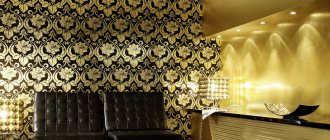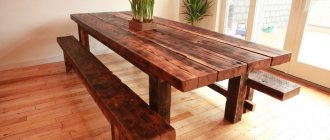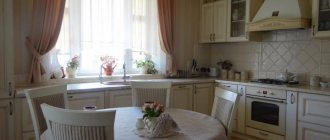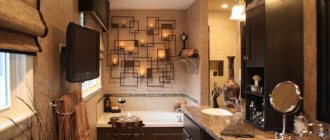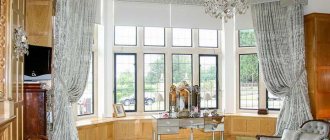Important Tips
When creating a pond in your country house, several important points should be addressed:
- in what part of the garden the pond will be located;
- what sizes, shape, depth and style are preferred;
- The purpose of the pond is to improve the territory, breed fish, for swimming, for gatherings with family or friends.
The pond can be used as a large aquarium Source bereg-a.ru
Selecting a location
When choosing a suitable location for a pond, you should pay attention to the topography of the site. The most successful area would be a slightly lowered area, or where puddles remain after rains. Perhaps this place has clay soils. A decorative pond at the dacha should fit into the overall landscape. More often, areas near gazebos or houses are chosen for its location.
A well-designed pond fits perfectly into the landscape Source divine-light.ru
Lighting plays an important role, as it will not allow algae to grow excessively and water blooms. Professionals recommend that the total duration of illumination of the reservoir during daylight hours should be no more than 6 hours, and shading in the middle of the day should be about 40%. With longer contact with the sun, the water may bloom.
We must carefully monitor the purity of the water. Source besideroom.co
If trees grow above the pond, then leaves and twigs will constantly float in the water Source krzewymarkus.pl
When choosing a location, you must remember that it is better to locate the pond away from trees. Falling leaves, seeds, and branches will pollute it. Although you can purchase protection if you wish.
An open pond under the trees will collect leaves Source pinterest.co.uk
Dimensions and shape
A pond can be of absolutely any shape: oval, round, rectangular, elongated, with various geometric bends. Dimensions are chosen depending on the available garden area, and depth depending on the type of purpose. A fashionable and spectacular combination of a pond with an alpine slide. The design of the pond at the dacha should be in the same style as the house and its plot. In general, the pond should fit perfectly into the overall landscape of the garden. For example, an irregularly shaped pond harmonizes perfectly with the oriental style.
Pond in an oriental style landscape Source iplaydeal.co
Purpose
If a pond is needed for territory design and air humidification, and there is not much space, then they opt for small reservoirs. If you want to add fish to the pond, you will need to maintain a comfortable (for them) water temperature.
Fish in an artificial pond Source pinterest.com
How to make a pond yourself. Pond operating principles
Water is a living biologically active component and all purification occurs due to the work of plants and beneficial microbes. For this purpose, the pond has a swimming area and a filtration area for plants. The filtration zone is actually the swamp part of our water zone, and just like in nature, it is this zone that guarantees the cleanliness of the entire reservoir. This zone must occupy at least 50 percent of the total surface area of the pond.
Natural stable biological balance can be achieved in ponds with an area of 100 sq.m. Smaller ponds require more of our attention, because... Their biological balance is precarious. Therefore, to maintain cleanliness, these ponds include a skimmer and UV sterilizer, but still offer a chemical-free swimming area and support the growth of aquatic plants.
It is useful to regularly enrich the water with oxygen by adding a small waterfall, stream or fountain to the pond. Although, an aerator can be used for the same purposes.
How is water purified in a pond?
You can see that the process of filtering water in a pond is not complicated:
- Water from the swimming area flows into the regeneration zone.
- The water circulates back to the bathing area.
Through drainage pipes under the plant roots in the regeneration zone and/or after the skimmer, water is pumped through the UV sterilizer to a waterfall, stream or to the bottom of the swimming area. The pipe leading to the bottom of the swimming area is raised slightly above the bottom so that the flow of water prevents the formation of silt on the bottom.
What should the shape of the pond be?
The pond bowl looks more like a soup bowl with large rims than a bathtub. The height difference should be about 30 cm for every meter of depth. It is this shape of the pond bowl that ensures the stability of the walls. The picture shows a cross section of a pond with a planting and swimming area:
After compacting the surface layer of soil in the pit, geotextiles and a sealed liner are laid on the bottom of the pond. In the plant area there are drainage pipes and gravel. In order to separate the swimming zone from the plant zone, a small mound is formed - its top is 3 cm lower from the surface of the water. You can make it from bags of sand or gravel. The mound allows water from the swimming zone to pass into the plant zone, where the water is filtered by plant roots, and at the same time protects the plants from fluctuations in the water of the swimming zone.
This pond design will allow you to conveniently clean the swimming area without affecting the plant area. In addition to cleaning the water, the shallow waters warm up quickly and provide habitat for frogs and other invertebrates, which you will appreciate when they begin to eat mosquito larvae.
To imitate the natural contours of a pond, use a combination of different pond edge profiles. If you place plants on the terraces of the pond, it is better to do this in pots so that they can be easily removed when cleaning the pond.
What size pond is suitable for our site?
The optimal size of the pond is 1/10 of the area of your site.
What about mosquitoes?
One of the first questions that arises when you hear the word “do-it-yourself pond” is what about mosquitoes? Mosquitoes breed only in stagnant water, but the water in a pond will never be static, so mosquitoes will find it unattractive for their habitat. Even if at some point they appear, the ecosystem of the pond in the form of frogs will reduce their population to a minimum.
Why make a pond at your dacha?
People who make a pond with their own hands make this decision because they want their pond to be a beautiful part of the landscape design and at the same time have a clean, attractive place for swimming on a hot day.
Is it possible to have fish in a swimming pond?
Unfortunately, fish, on the one hand, happily eat beneficial microflora, on the other hand, they are carriers of pathogenic bacteria, so there should be no fish in bathhouses.
Is it possible to make a sandy beach on a pond?
The best solution for entering the pond is a walkway or ladder. For a beach entrance to the water, you need enough area, because... The angle of entry into the water is small. In addition, the sand quickly silts up - those beaches that we see are often simply trampled down to sand, most of the shore of the pond is usually densely overgrown with plants.
Should I swim with frogs?
Yes, frogs are full-fledged and important inhabitants of the pond. Additionally, to purify the water in the pond, it is good to have bivalve shells or pearl barley, which filter water up to 40 liters per day. You can also get snails (coils, livebearers) - they eat dead plants and clean the pond well.
What's the best place for a pond?
It is better to place the pond away from trees, because... falling, the leaves will rot in the pond. Moreover, growing roots can damage the waterproofing film or tilt the finished container. The illumination of the area should be about 5 hours in the morning, and the rest of the time should be in partial shade. The pond does not need high illumination because... leads to increased formation of algae and overheating of water in the reservoir.
What to do with a pond in winter?
In winter, the pond, like natural bodies of water, freezes. There is no need to drain it. For the winter, all equipment (pumps, filters, skimmers) must be removed from the pond.
Does soil type affect the creation of a pond?
No, the composition of the soil does not affect it. There is a misconception that it is good when the groundwater level is high. In fact, groundwater at the freezing level is more of a problem. When ice freezes, it can bulge the bottom of the pond. This is especially problematic if the pond is made on the basis of a rigid finished mold.
Types of country ponds
There are several types of decorative ponds, among which are the following:
- small
– as a bright zone in a small garden;
- central composition
– an element of general design in the landscape of the site, maybe with lighting, a bridge, a fountain or waterfall, a stream;
- pond with fish
– where exotic decorative bright fish may live, or crayfish and carp that can be caught;
- decorative pool for a summer residence
- one of the most popular in recent years, both adults and children can swim in it.
It is easier to monitor the ecosystem of a large pond.
When breeding several breeds of fish in a pond, you need to pay attention to their compatibility Source matgoblog.xyz
On our website you can find contacts of construction companies that offer ] development and implementation of landscape work of any complexity[/anchor]. You can communicate directly with representatives by visiting the “Low-Rise Country” exhibition of houses.
Materials used
Waterproofing materials that will be needed for arranging a reservoir can be as follows:
- Film for creating a pond
– the material is elastic, suitable for universal projects. Butyl rubber is the most durable of the films and has different thicknesses, depending on the depth of the future pond. For a shallow reservoir up to 1 meter, 0.8 mm is enough, and for deeper ones from 1.5 mm. Polyethylene is a cheaper type, but it is not durable either. Possible deformations that can be eliminated with self-adhesive tape. Polyvinyl chloride is usually black and can be repaired with glue if it breaks.
Film is one of the simplest options for creating a pond Source pinterest.com
- Plastic
– for small ponds (5-6 sq.m.), plastic containers are quite appropriate. They are easy to install, and their service life is up to several decades.
Pond with a base made of a plastic container Source pro-remont.org
- Concrete pit
– when choosing a large pond with straight geometry. Here you will need to fill the walls and transitions between the terraces.
Concrete pouring - for a medium and large pond Source landshaftdizajn.ru
You can use any waterproof material, including roofing felt, or a reliable sealant - polyurea.
Creating a pond using film
You also need to start creating a pond using film by digging a pit. Pegs and twine are also used for marking. But now you will have to do the bottom relief yourself. All height differences must be taken into account at this stage, since after laying the film it will be difficult to correct anything. First, as in the case of the finished form, it is necessary to draw a rough plan. In this case, it is advisable to immediately mark on the plan where coastal plants will be located and where deep-sea plants will be located. A wintering pit for fish, if required, is immediately marked on the plan.
The wintering pit is the deepest place in the reservoir, where a temperature comfortable for fish is maintained in winter. In order not to dig the entire pit to a depth of 1.5 - 1.8 m. In the center of the future pond, a hole of the required depth is usually dug.
Approximate plan of the future pond.
When digging a pit, you need to periodically check the height using a board and level. The number of tiers can be any. When the first tier is ready and leveled, you can proceed to the second. Depending on the depth of groundwater, the pit may be filled with water during operation. In this case, a drainage pump for dirty water can help.
A drainage pump is a device designed to drain flooded pits, ponds and rooms. Unlike a conventional submersible pump, this device is installed on a solid surface and can pump water containing large particles. A drainage pump can be useful if you need to drain a pond, for example, when redeveloping a site.
It is necessary to dig a ditch along the perimeter of the reservoir to secure the film. When the pit is ready, you need to measure its area to purchase the required amount of film. The twine used for marking is suitable for measuring. When calculating the area, it is necessary to take into account an allowance of 50 cm.
Before laying the film, the dug pit for the pond must be cleared of stones, roots and other foreign objects that could damage the material. Then a layer of sand (5 cm) is poured into the bowl of the pond, and a layer of geotextile is placed on it; old linoleum, newspapers or roofing felt are also suitable. After this, you can proceed to laying the film.
When covering the bottom of the pond, it is important to smooth out the film so that folds with air do not form under it. The film is secured with crushed stones and stones in the previously dug ditch. You can also put stones on the tiers of the reservoir and fill it with crushed stone for additional fixation of the film. In this state, the pond must be left for a day, then the excess film can be cut off.
Along the perimeter of the pit there is a special trench for attaching the film.
The edges of the film are well fixed with stones or crushed stone.
To give a natural look to the edges of the shore of a reservoir, the film is masked with stones and plants. You can build a blind area, the material for it is chosen according to your taste: tiles, flat natural stone, brick, etc. are suitable. You can secure the blind area using a cement solution.
Beginning of work
At the site of the future reservoir, soil is removed, according to the design idea, to a certain depth, observing the dimensions and geometry. Several levels of terraces are formed, if provided for. The recommended level of inclination of the edges of the pit is 45 degrees; the walls must be narrowed towards the bottom. This helps reduce the pressure of the water mass and protects against soil collapse. Next, lay a layer of sand on the bottom and walls, water it with water, then compact everything. For a stronger, deeper structure, and when introducing fish into a pond, the walls are made in the form of terraces going down, preferably on a slope. The depth of the reservoir should not be less than 80 cm, as it will warm up and the life of the fish will be impossible.
The shallower the depth of the pond, the more the water in it will warm up. Source artc-alisa.ru
Waterproofing
The next important stage is waterproofing. The bottom and walls of the pit are covered with waterproofing. The material is laid with an overlap, it is necessary to tightly fit the layers to each other. The waterproofing should extend to the edges of the future reservoir. It is covered with soil, and then, if desired, and in accordance with the style, stones, flowers in pots, and alpine slides are used along the edges. A decorative pond for a summer residence can be filled with water.
Good waterproofing is the basis of any design Source yandex.uz
This might be interesting!
In the article at the following link, read about the types of plastic ponds.
Plastic
When choosing the option using a plastic container, it is enough to select a suitable shape and install it in a dug pit, with the bottom as flat as possible. The gaps between the walls of the container and the edges of the pit are filled with soil and sand and compacted. The plastic container is easy to clean, can withstand heavy loads, and has various configurations. A decorative plastic pond can be either a central object near the veranda for picnics or an ordinary natural reservoir. This option can be used as a safe swimming pool for small children.
A plastic container is the minimum amount of work required Source m.yandex.by
Concrete structure
In a dug pit, a sand and gravel cushion up to 30 cm high is poured, then a supporting concrete slab up to 10 cm thick is cast. Next, the reinforcement of the walls of the future pond is installed using rebar (A12mm). It is tied with wire, creating a kind of mesh with cells of 20x20 cm, and secured by welding. At the reinforcement stage, the installation of embedded parts is carried out:
- pipes, drains;
- lighting and other electrical equipment;
- nozzles, skimmers for cleaning.
The formwork is installed using wooden beams and plywood (treated with moisture-resistant septic tanks). The last step is concreting the bowl; concrete grade M350, intended for this work, is selected. Experts recommend filling the bottom in one go, using the same principle for the sides of the bowl. The overflow gutter is formed simultaneously with the sides. After the concrete has hardened, the surface is treated with sealants.
Concrete can be used to form any shape Source houzz.com
To prevent water from penetrating through a cold joint, a self-expanding concrete cord is installed in the joints when pouring, which expands several times when exposed to water. The surface is leveled using plaster. If desired, you can line the bowl with pool tiles. The concrete structure can be used as a decorative pool for swimming, and as a reservoir for launching fish and growing aquatic plants.
Decorating a pond with large pebbles Source fontalife.ru
This might be interesting!
In the article at the following link, read about the fountain for the pond.
Pond arrangement
When planning cascades, fountains, and jets, a waterproof electrical cable is installed underground in advance to the pond. Pumps and lighting are usually connected to the same source. There are only so many options on how to beautifully design an artificial pond at your dacha in a plastic form or in a concrete structure with energy design elements:
- A small waterfall, cascade or water mill is located on the edge of the pond. They go well with the alpine slide and the corresponding plants.
- A very popular option is a closed-circuit fountain. The pump drives water from the reservoir into the fountain bowl and back.
In both cases, the sound of water has a calming effect on the nervous system, provides additional coolness in the heat, and most importantly, makes the landscape very attractive and lively. The use of additional lighting in and above the water, as well as along the contour of the pond, in the evenings will create a unique atmosphere of comfort and tranquility.
Pond with mini waterfall Source worldbignews.info
Beginning of pond construction: end of the first day of work
In fact, the work of the first day can be considered almost completed. All that remains is to fill the future pond with water and you can relax. Until the next day, the banner will straighten out and take its shape. In addition, you will be able to see if there is any water leakage. After all, there may be an unnoticeable hole in the substrate, and we do not need this at all.
Water is poured into the future pond to the brim so that even the slightest leak is noticeable the next day. If such a problem is found, it would be better to change the substrate.
The resulting “pool” must be filled with water and left until the next day.
Plants
To decorate the area near the pond, plants that love moist soil and belong to the coastal group are used:
- marigold and buttercups, little tea;
- astilbe is a bright plant, with a long flowering period and many varieties;
- knotweed and beautiful molinia, which is distinguished by the unique shape of the bush, ideally framing the pond;
- ferns and sedges - visually increasing the size of a small pond;
- miscanthus - beautiful lush green caps of thin tall leaves.
Plants can be planted in soil or pots. On the shoreline of the pond, they protect the reservoir from overheating.
Decorating a pond with moisture-loving plants Source zemeljka.ru
This might be interesting!
In the article at the following link, read about pond cleaning.
Among the aquatic plants for pond design, you can choose the following:
- egg capsules, marigold, duckweed are unpretentious and suitable for small ponds;
- water lily, reed - for large bodies of water;
- swamp turcha and water star - they produce oxygen and are necessary where there are fish, as they provide food for them;
If there are fish living in the pond, then experts advise introducing the fish and a predator from the flora - this is bladderwort. She will “finish” the remaining food for the fish.
Mini pond among garden greenery Source comfycozyhome.ru
We make a pond with our own hands. Shore decoration
After you have made a pond with your own hands, before you start decorating the shore, you need to water it generously and wait 2-3 days, because... shrinkage is possible. In addition, during this time the water in the pond will settle.
We mask the film on the shore with crushed stones, stones, and snags. We plant plants in shallow water. A pond needs plants that saturate the water with oxygen. There are many suitable plants - reeds, crabgrass, iris, bathwort, marigold, arrowhead. Any plant that grows on the shore of a natural body of water will be suitable for your pond. Don't forget about algae, such as hornwort, which just floats in the water. Deciduous ornamental shrubs are best planted behind marsh grasses, which are planted directly on the shore.
Illumination adds additional charm to the pond.
Floating flower beds look seductive on the surface of the pond.
Pond safety
If there are very young children in the family, then perhaps the construction of a pond should be postponed until they are older. It is necessary to consider visiting the pond by elderly people and school-age children. Make a convenient ladder to enter the pond, don't forget to clean it so it doesn't become slippery! It is better to cover all other sides of the pond, except the entrance, with plants.
Pond care.
The new pond will take on its natural appearance over the course of a year - while it forms its own ecosystem. The small world of your pond is very vulnerable. The pond may quickly heat up or freeze, water may evaporate, or the pond may overflow after rain. This puts stress on aquatic life that cannot immediately transition to a safer, more stable environment.
Therefore, your pond, like any living organism, requires care. On a hot day, you need to add water, use a net to collect debris that floats on the surface, check whether the plants have grown or perhaps something has not taken root and needs to be replanted. However, a surprising number of life forms will colonize your new pond; they will quickly explore new waters and will stay if conditions suit them.
The quiet splash of water is the most enchanting melody of a hot summer; water bewitches, attracts and seduces us with a playful play of light, transparent depth and invigorating coolness. A DIY pond will give your dacha a special charm.
Coastline decoration
A beautiful design of the shoreline of a pond is as necessary as an evening dress for a lady. Thanks to him, the pond gets a noble and finished look. There are many options you can use:
- film for decoration with gravel and imitation stone;
- decoration with slabs or tiles;
- creation of bridges, hanging slabs, decking;
- using pebbles and stones of various shapes.
A nuance - the larger the size of the pond, the larger the stones used in the design. The right step would be to alternate both stones and plants. The stones are fixed in cement mortar to a third of their size for strength.
Terrace on the water Source pinterest.ph
Another original solution for the terrace Source hug-fu.com
Do-it-yourself pond at the dacha: landscape photo ideas and decoration
Do-it-yourself dacha ponds require special design. The photo shows the best design techniques. Figurines, stones and beautiful trees can be used as decoration. Changes and uneven terrain make it possible to build a reservoir with a cascade and a waterfall. An original solution would be a bridge or an artificial slide.
You can decorate a pond using plastic plants
The finished structure can be decorated with the following elements:
- Underwater lighting looks fascinating; mini spotlights are installed for this purpose;
Options for such lighting require certain skills
- overwater lighting is installed next to the reservoir; halogen and LED lamps are used for this;
The lighting looks fabulous from all sides
- To install fountains, different types of pumps will be required.
Fountains can be calming or, on the contrary, energizing
Vegetation is considered an important decoration. It can be planted in baskets filled with soil and placed on the surface of a reservoir. Tall varieties of plants will look good nearby.
Helpful information! Before purchasing fish, you need to clarify the conditions for keeping them. Some types of fish are at enmity with each other, so you need to choose ones that get along with each other.
Stylistics
The design of the pond will benefit greatly if it is in harmony with the main style of the landscape. A variety of styles can suit every taste:
- French
– beauty and severity of forms, elegance. The banks of the reservoirs rise slightly above the ground. The style is characterized by steps with cascades or fountains. Sculptures, stones, and plants would be appropriate.
French reservoir Source yandex.ru
- Italian
– It is symmetrical and is placed in the center of the garden. The forms are often multi-stage with fountains and cascades. A large amount of greenery in pots and additional lighting are welcome.
Italian motifs in pond design Source fairygardenhavens.com
- English
- the easiest, without clear boundaries, shrubs and trees are acceptable nearby.
Simplicity of English style Source yandex.ru
- Japanese
– maximum naturalness and soft lines, cascades, but without fountains. In addition there are Buddha statues, dragons, a lot of stone and greenery.
The beauty of the Japanese garden Source eksioglupeyzaj.com
- Chinese
– appropriate with a Chinese garden. There is a bridge across the pond, and a gazebo for tea drinking is desirable nearby. The obligatory abundance of fish, lotuses, lush vegetation and many boulders and stones.
Decoration in Chinese style Source homepic.com.ua
Pond care
After arranging a pond in the garden, you will have to regularly care for it. Clean the reservoir bowl in spring and autumn, and plant plants at the beginning of summer. During the summer season, clean the bottom and surface of the water. It is necessary to control the quality of water, especially if fish live there, and to care for plants. In autumn, perennial plants are removed for the winter, water from the pond is drained, pumps and filters are cleaned and dried.
The reservoir should always be kept clean Source cleversad.ru
Useful tips: how to arrange a pond at your dacha with your own hands, video
Recommendations from experts will allow you to create a beautiful pond at your dacha with your own hands. Using step-by-step photos, you can consider in detail the methods of high-quality arrangement:
- It is better to decorate the pond with stones of different sizes. A harmonious combination of blocks with small stones will create a magnificent look;
Cobblestones of different sizes give the structure a natural look
- When creating a reservoir, you should not use steep surfaces on which it is difficult to place plants;
- When gardening, you should use containers that will prevent the plants from growing too much.
The plant in the container looks as if it is growing out of water
Helpful information! Planting aquatic crops requires special soil. In this case, plants should not occupy more than half the area of the reservoir.



